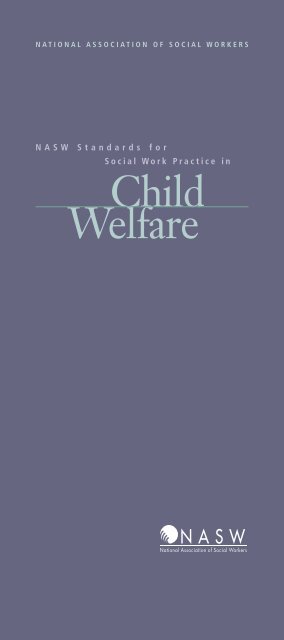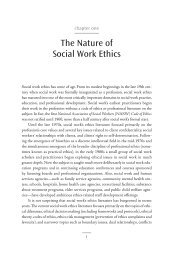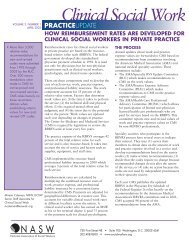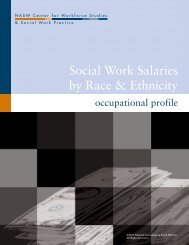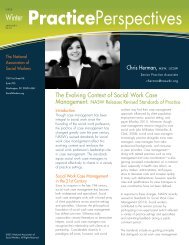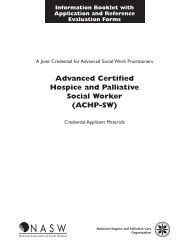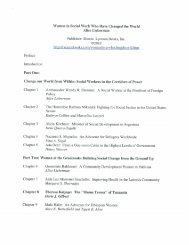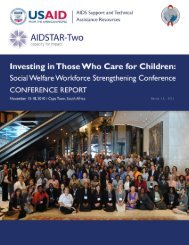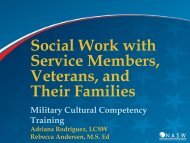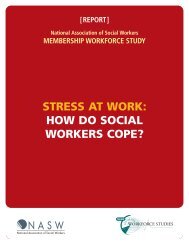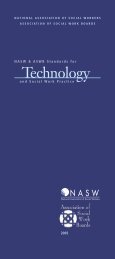Child Welfare - National Association of Social Workers
Child Welfare - National Association of Social Workers
Child Welfare - National Association of Social Workers
Create successful ePaper yourself
Turn your PDF publications into a flip-book with our unique Google optimized e-Paper software.
N A T I O N A L A S S O C I A T I O N O F S O C I A L W O R K E R S<br />
N A S W<br />
S t a n d a r d s f o r<br />
S o c i a l W o r k P r a c t i c e i n<br />
<strong>Child</strong><br />
<strong>Welfare</strong>
N A S W<br />
S t a n d a r d s f o r<br />
S o c i a l W o r k P r a c t i c e i n<br />
<strong>Child</strong><br />
<strong>Welfare</strong>
<strong>National</strong> <strong>Association</strong> <strong>of</strong> <strong>Social</strong> <strong>Workers</strong><br />
Jeane W. Anastas, PhD, LMSW<br />
President<br />
Elizabeth J. Clark, PhD, ACSW, MPH<br />
Chief Executive Officer<br />
Standards for <strong>Social</strong> Work Practice in<br />
<strong>Child</strong> <strong>Welfare</strong> Work Group<br />
Kim Day, MSW<br />
Carol Harper, BSW, MPA<br />
Carmen D. Weisner, LCSW, ACSW<br />
NASW Staff<br />
Tracy R. Whitaker, DSW, ACSW<br />
Roxana Torrico Meruvia, MSW<br />
©2013 <strong>National</strong> <strong>Association</strong> <strong>of</strong> <strong>Social</strong> <strong>Workers</strong>.<br />
All Rights Reserved.
Contents<br />
5 Background <strong>of</strong> Standards for <strong>Child</strong> <strong>Welfare</strong><br />
5 Introduction<br />
8 Goals <strong>of</strong> the Standards<br />
9 Definitions<br />
12 Standards<br />
12 Standard 1. Ethics and Values<br />
13 Standard 2. Qualifications, Knowledge, and<br />
Practice Requirements<br />
14 Standard 3. Pr<strong>of</strong>essional Development<br />
15 Standard 4. Advocacy<br />
15 Standard 5. Collaboration<br />
16 Standard 6. Record Keeping and Confidentiality <strong>of</strong><br />
Client Information<br />
18 Standard 7. Cultural Competence<br />
19 Standard 8. Assessment<br />
20 Standard 9. Intervention<br />
21 Standard 10. Family Engagement<br />
22 Standard 11. Youth Engagement<br />
22 Standard 12. Permanency Planning<br />
23 Standard 13. Supervision<br />
24 Standard 14. Administration<br />
25 References
Background <strong>of</strong> Standards for <strong>Child</strong> <strong>Welfare</strong><br />
The <strong>National</strong> <strong>Association</strong> <strong>of</strong> <strong>Social</strong> <strong>Workers</strong><br />
(NASW) led the field in the development <strong>of</strong><br />
best practices for social workers in child welfare.<br />
The NASW Standards for <strong>Social</strong> Work Practice in<br />
<strong>Child</strong> Protection (1981) served as an initial effort<br />
to formulate standards in this important and<br />
continually evolving area <strong>of</strong> practice. Because it<br />
is essential that standards reflect and promote<br />
sound social work practice across the full array<br />
<strong>of</strong> child welfare services, they were revised and<br />
expanded to address changing practices and<br />
polices beyond child protection. NASW<br />
periodically revises the NASW Standards for<br />
<strong>Social</strong> Work Practice in <strong>Child</strong> <strong>Welfare</strong> to meet the<br />
current practice trends and to reflect the values<br />
<strong>of</strong> the pr<strong>of</strong>ession. These standards can be<br />
regarded as a basic tool for social work practice<br />
in child welfare, which may include prevention,<br />
parenting programs, family support programs,<br />
family-based services, family foster care, kinship<br />
care, residential group homes, adoption, and<br />
independent living. Since the NASW <strong>Child</strong><br />
Protection Standards were initially published,<br />
there have been many pr<strong>of</strong>ound practice and<br />
policy changes in the child welfare field. <strong>Child</strong><br />
welfare systems are complex, and child welfare<br />
as a specialized field <strong>of</strong> practice is affected by<br />
and contributes to evolutions in policy, research,<br />
and practice models (NASW, 2005).<br />
Introduction<br />
<strong>Child</strong> welfare systems across the country serve<br />
some <strong>of</strong> the most vulnerable children, youths,<br />
and families. These systems are designed to<br />
5
support families and to protect children from<br />
harm through an array <strong>of</strong> prevention and<br />
intervention services; in particular, they are<br />
designed to support children who have been or<br />
are at risk <strong>of</strong> abuse or neglect. Historically,<br />
social workers have played critical roles in these<br />
systems (NASW, 2005). Studies indicate that<br />
social work degrees are the most appropriate<br />
degrees for this field <strong>of</strong> practice (<strong>Child</strong> <strong>Welfare</strong><br />
League <strong>of</strong> America, 2002) and have been<br />
directly linked to better outcomes for children<br />
and families and retention <strong>of</strong> staff (Zlotnik,<br />
DePanfilis, Daining & Lane, 2005).<br />
<strong>Social</strong> workers practicing in the child welfare<br />
field <strong>of</strong>ten face the need to make critical<br />
decisions while working in stressful work<br />
environments that can include high case loads<br />
and limited supervision, training, and supports.<br />
High caseloads and workloads are also<br />
contributing factors to staff turnover (American<br />
Public Human Services <strong>Association</strong>, 2005;<br />
Torrico Meruvia, 2010). Other stressful work<br />
conditions such as inadequate salaries,<br />
administrative burdens, and fear <strong>of</strong> violence also<br />
influence the recruitment and retention <strong>of</strong><br />
qualified staff (Torrico Meruvia, 2010; Whitaker,<br />
Reich, Brice Reid, Williams, & Woodside,<br />
2004). Increasingly, child welfare workers also<br />
face legal challenges when intervening to<br />
protect children (Camreta v. Greene, 2011;<br />
Franet v. County <strong>of</strong> Alameda, 2008;<br />
Southerland v. City <strong>of</strong> New York, 2012).<br />
Economic, social, and political factors significantly<br />
affect the child welfare system and the number<br />
<strong>of</strong> children and youths needing and receiving<br />
child welfare services. These factors challenge<br />
6
current policies and practice approaches and<br />
place greater demands on the child welfare<br />
system to respond to the needs <strong>of</strong> children and<br />
youths who are at risk and their families.<br />
Although child welfare is designed to protect<br />
children from harm, ensure their well-being,<br />
help them to achieve permanency, and<br />
strengthen families (<strong>Child</strong> <strong>Welfare</strong> Information<br />
Gateway, 2012), child welfare systems cannot be<br />
expected to bear the sole responsibility for a<br />
child’s well-being. An increasing number <strong>of</strong><br />
communities are engaged in partnerships and<br />
collaborations with child welfare agencies<br />
focused on preventing child abuse and neglect<br />
and other public and private agencies committed<br />
to providing family support services. Work<br />
across disciplines is critical to promoting<br />
children’s well-being—teachers, community and<br />
faith leaders, medical pr<strong>of</strong>essionals, police<br />
<strong>of</strong>ficers, juvenile probation <strong>of</strong>ficers, and child<br />
welfare workers are among the pr<strong>of</strong>essionals<br />
who can work together to keep children and<br />
youths safe.<br />
Across the country, child welfare systems also<br />
include a combination <strong>of</strong> public and private<br />
agency providers. The roles, priorities, and<br />
practices <strong>of</strong> child welfare will continue to<br />
change as we look to the future. To better serve<br />
vulnerable children, youths, and their families,<br />
we need to continue to build bridges across<br />
child welfare and other systems.<br />
7
Goals <strong>of</strong> the Standards<br />
These standards were developed to broadly<br />
define the scope <strong>of</strong> services that child welfare<br />
social workers shall provide; that administrators<br />
should support; and that children, youths, and<br />
families should expect. The standards are<br />
designed to enhance awareness <strong>of</strong> the skills,<br />
knowledge, values, methods, and sensitivities<br />
social workers need to work effectively within<br />
the child welfare system.<br />
Ideally, these standards will stimulate the<br />
development and implementation <strong>of</strong> clear<br />
guidelines, goals, and objectives related to<br />
child welfare services in social work practice,<br />
research, and policy. The specific goals <strong>of</strong> the<br />
standards are to<br />
n establish expectations for child welfare<br />
practice and services<br />
n ensure that child welfare practice is guided<br />
by the NASW Code <strong>of</strong> Ethics<br />
n assure that social work services <strong>of</strong> the highest<br />
quality are provided to children, youths,<br />
and families<br />
n provide a base from which to advocate for<br />
children, youths, and families to be treated<br />
with respect and dignity and have access to<br />
supportive and confidential services and<br />
appropriate inclusion in decision making<br />
n provide a foundation for the preparation <strong>of</strong><br />
child welfare social workers and the<br />
development <strong>of</strong> continuing education<br />
materials and programs<br />
n encourage social workers in child welfare<br />
to participate in the development and<br />
refinement <strong>of</strong> public policy at the local,<br />
8
state, and federal levels to support the<br />
well-being <strong>of</strong> children and youths and to<br />
engage in program evaluation and research<br />
aimed to enhance practice.<br />
Definitions<br />
Advocacy<br />
Advocacy is the act <strong>of</strong> supporting the rights <strong>of</strong><br />
individuals or communities through<br />
interventions or empowerment (Barker, 2003).<br />
Caseload<br />
A caseload comprises the individuals—including<br />
children, youths, and families—for whom the<br />
social worker is responsible.<br />
<strong>Child</strong> welfare services<br />
<strong>Child</strong> welfare systems include a range <strong>of</strong><br />
services (for example, family-based services,<br />
child protection, out-<strong>of</strong>-home placements,<br />
adoption services), encompassing prevention,<br />
intervention, and treatment. Services are<br />
intended to protect children and their<br />
well-being, strengthen families, and provide<br />
permanency when children cannot safely remain<br />
with their families. <strong>Child</strong> welfare services should<br />
be strength based; family centered; trauma<br />
informed; and respectful <strong>of</strong> a family’s culture,<br />
values, customs, beliefs, and needs (<strong>Child</strong><br />
<strong>Welfare</strong> League <strong>of</strong> America, 2005).<br />
Collaboration<br />
Collaboration is the process by which<br />
individuals and organizations work together<br />
toward a common purpose.<br />
9
Culture<br />
Culture refers to “the customs, habits, skills,<br />
technology, arts, values, ideology, science, and<br />
religious and political behavior <strong>of</strong> a group <strong>of</strong><br />
people in a specific time period” (Barker, 2003,<br />
p. 105). Culture includes ways in which<br />
individuals with disabilities or individuals <strong>of</strong><br />
various races, ethnicities, and religious and sexual<br />
orientations experience the world around them.<br />
Cultural competence<br />
Cultural competence is “the ability <strong>of</strong><br />
individuals and systems to respond respectfully<br />
and effectively to people <strong>of</strong> all cultures, classes,<br />
races, ethnic backgrounds, sexual orientations,<br />
and faiths or religions in a manner that<br />
recognizes, affirms, and values the worth <strong>of</strong><br />
individuals, families, tribes, and communities<br />
and protects and preserves the dignity <strong>of</strong> each.<br />
Cultural competence is a vehicle used to<br />
broaden our knowledge and understanding <strong>of</strong><br />
individuals and communities through a<br />
continuous process <strong>of</strong> learning about the<br />
cultural strengths <strong>of</strong> others and integrating their<br />
unique abilities and perspectives into our lives”<br />
(<strong>Child</strong> <strong>Welfare</strong> League <strong>of</strong> America, n.d.).<br />
Evidence-based practice<br />
Evidence-based practice is “the use <strong>of</strong> the best<br />
available scientific knowledge derived from<br />
randomized controlled outcome studies and<br />
meta-analyses <strong>of</strong> existing outcome studies, as<br />
one basis for guiding pr<strong>of</strong>essional interventions<br />
and effective therapies, combined with<br />
pr<strong>of</strong>essional ethical standards, clinical judgment,<br />
and practice wisdom” (Barker, 2003, p. 149).<br />
10
Out-<strong>of</strong>-home care<br />
Out-<strong>of</strong>-home care describes an array <strong>of</strong><br />
services—including family foster care, kinship<br />
care, and group residential care—for children or<br />
youths who have been placed in the custody <strong>of</strong><br />
the state and who require living arrangements<br />
away from their birth or adoptive parents.<br />
Permanency planning<br />
Permanency planning is a process that intends<br />
to limit placement into and time spent in<br />
out-<strong>of</strong>-home care. “Planned and systematic efforts<br />
are made to ensure that children are in safe and<br />
nurturing relationships expected to last a lifetime”<br />
(<strong>Child</strong> <strong>Welfare</strong> League <strong>of</strong> America, n.d.).<br />
<strong>Social</strong> worker<br />
<strong>Social</strong> workers are pr<strong>of</strong>essionals who possess a<br />
degree in social work from a school or program<br />
accredited by the Council on <strong>Social</strong> Work<br />
Education (CSWE). <strong>Social</strong> workers help<br />
individuals increase their capacities to solve<br />
problems and access resources, facilitate<br />
interactions, make organizations responsible to<br />
people, and influence social policies (Barker,<br />
2003). Licensing and certification regulations<br />
vary across states.<br />
Youth development<br />
“Youth development is an ongoing process in<br />
which young people are engaged in meeting<br />
their basic needs and developing the skills and<br />
competencies needed to become contributing<br />
members <strong>of</strong> society” (<strong>Child</strong> <strong>Welfare</strong> League <strong>of</strong><br />
America, 2005, p. 2).<br />
Note: The terms “social worker” and “social<br />
worker in child welfare” are used<br />
interchangeably throughout this document.<br />
11
Standards<br />
Standard 1. Ethics and Values<br />
<strong>Social</strong> workers in child welfare shall<br />
demonstrate a commitment to the values and<br />
ethics <strong>of</strong> the social work pr<strong>of</strong>ession and shall<br />
use NASW’s Code <strong>of</strong> Ethics as a guide to ethical<br />
decision making while understanding the<br />
unique aspects <strong>of</strong> child welfare practice.<br />
Interpretation<br />
A social worker in child welfare shall<br />
demonstrate the core values <strong>of</strong> service, social<br />
justice, the dignity and worth <strong>of</strong> the person, the<br />
importance <strong>of</strong> relationships, integrity, and<br />
competence. In addition, social workers shall<br />
adhere to the pr<strong>of</strong>essional ethical responsibilities<br />
delineated in the NASW Code <strong>of</strong> Ethics.<br />
The Code <strong>of</strong> Ethics establishes the ethical<br />
responsibilities <strong>of</strong> all social workers with respect<br />
to themselves, clients, colleagues, employees and<br />
employing organizations, the social work<br />
pr<strong>of</strong>ession, and society. Acceptance <strong>of</strong> these<br />
responsibilities guides and fosters competent<br />
social work practice in child welfare.<br />
As an integral component <strong>of</strong> the child welfare<br />
system, social workers have the responsibility to<br />
know and comply with local, state, and federal<br />
legislations, regulations, and policies. In some<br />
instances, legal and regulatory guidelines and<br />
administrative practices may conflict with the<br />
best interests <strong>of</strong> a child and/or family. In the<br />
event that conflicts arise among competing<br />
expectations, child welfare social workers are<br />
directed to the NASW Code <strong>of</strong> Ethics as a tool in<br />
their decision making. However, they should<br />
also seek guidance from supervisors and/or<br />
other relevant pr<strong>of</strong>essionals.<br />
12
Standard 2. Qualifications, Knowledge, and<br />
Practice Requirements<br />
<strong>Social</strong> workers practicing in child welfare shall<br />
hold a BSW or MSW degree from an accredited<br />
school <strong>of</strong> social work. All social workers in<br />
child welfare shall demonstrate a working<br />
knowledge <strong>of</strong> current theory and practice in<br />
child welfare and general knowledge <strong>of</strong> state<br />
and federal child welfare laws.<br />
Interpretation<br />
Although hiring requirements for social workers<br />
in child welfare vary across the country, the<br />
knowledge requirements considered fundamental<br />
to all social work practice, which are met by<br />
completion <strong>of</strong> BSW and MSW programs within<br />
colleges and universities and accredited by<br />
CSWE, must include knowledge about the<br />
history and development <strong>of</strong> social work,<br />
including child welfare. <strong>Social</strong> workers in child<br />
welfare shall also possess working knowledge<br />
related to child and adult development, impact<br />
<strong>of</strong> trauma, parenting and family dynamics, and<br />
community systems where the child and family<br />
reside. In addition, social workers in child<br />
welfare shall have a proven ability to apply this<br />
knowledge to appropriately intervene in family,<br />
organizational, and social systems. These<br />
interventions should help to address the needs<br />
<strong>of</strong> children and families. Interventions should<br />
also aim to prevent harm to the child and<br />
maximize the family’s chances for positive<br />
functioning and stability.<br />
<strong>Social</strong> workers practicing in child welfare shall<br />
also stay up to date on current practice models<br />
and new laws and regulations that can affect<br />
child welfare practice. <strong>Child</strong> welfare agencies<br />
should ensure that information regarding new<br />
13
laws and federal regulations are disseminated<br />
and explained to staff in a timely manner.<br />
<strong>Social</strong> workers in child welfare shall seek the<br />
advice and counsel <strong>of</strong> colleagues whenever such<br />
consultation is in the best interests <strong>of</strong> clients.<br />
Consultation should include counsel and<br />
guidance from supervisors, other social workers,<br />
and other disciplines with relevant expertise.<br />
However, “social workers should protect the<br />
confidentiality <strong>of</strong> all information obtained in the<br />
course <strong>of</strong> pr<strong>of</strong>essional service, except for<br />
compelling pr<strong>of</strong>essional reasons” (NASW, 2008,<br />
p. 10). <strong>Social</strong> workers shall disclose confidential<br />
information when appropriate and with written<br />
consent from the client (NASW, 2008).<br />
Standard 3. Pr<strong>of</strong>essional Development<br />
<strong>Social</strong> workers in child welfare shall<br />
continuously build their knowledge and skills<br />
to provide the most current, beneficial, and<br />
culturally appropriate services to children,<br />
youths, and families involved in child welfare.<br />
Interpretation<br />
<strong>Social</strong> workers in child welfare shall adhere to<br />
the NASW Standards for Continuing Pr<strong>of</strong>essional<br />
Education (2003) and follow state pr<strong>of</strong>essional or<br />
licensing regulations regarding continuing<br />
education requirements. Ongoing pr<strong>of</strong>essional<br />
development is critical to ensuring quality social<br />
work services for children, youths, and families.<br />
<strong>Social</strong> workers shall participate in pr<strong>of</strong>essional<br />
development activities that enhance their<br />
knowledge and skills. Frequent participation<br />
in educational opportunities can help social<br />
workers to maintain and increase pr<strong>of</strong>iciency<br />
in service delivery.<br />
14
<strong>Social</strong> workers in child welfare shall also<br />
contribute to the development <strong>of</strong> the pr<strong>of</strong>ession<br />
by educating and supervising social work interns<br />
when possible.<br />
Standard 4. Advocacy<br />
<strong>Social</strong> workers in child welfare shall seek to<br />
advocate for resources and system reforms<br />
that will improve services for children, youths,<br />
and families.<br />
Interpretation<br />
<strong>Social</strong> workers shall use their skills and knowledge<br />
to advocate for the well-being <strong>of</strong> children,<br />
youths, and their families. This advocacy<br />
includes helping clients to access and effectively<br />
use formal and informal community resources<br />
that enable them to self-advocate. Advocacy<br />
efforts should also be directed toward improving<br />
administrative and public policies to support<br />
children and their families. Advocacy efforts<br />
should emphasize the strengths and assets<br />
approach in the development <strong>of</strong> social services<br />
and child welfare programs and the use <strong>of</strong><br />
evidence-based practice and policies.<br />
Standard 5. Collaboration<br />
<strong>Social</strong> workers in child welfare shall promote<br />
interdisciplinary and interorganizational<br />
collaboration to support, enhance, and<br />
deliver effective services to children,<br />
youths, and families.<br />
Interpretation<br />
Multiple service providers <strong>of</strong>ten serve children,<br />
youths, and families involved with child welfare.<br />
<strong>Social</strong> workers shall understand the roles and<br />
goals <strong>of</strong> other pr<strong>of</strong>essionals and work toward<br />
more effective collaborations and understanding.<br />
15
Such collaborations can include multidisciplinary<br />
teams; community leaders; and other service<br />
providers in the fields <strong>of</strong> law, juvenile justice,<br />
medicine, public health, housing, education, and<br />
behavioral health. Collaborations can ensure<br />
that children, youths, and families access needed<br />
services without duplication.<br />
Standard 6. Record Keeping and<br />
Confidentiality <strong>of</strong> Client Information<br />
<strong>Social</strong> workers in child welfare shall maintain<br />
the appropriate safeguards for the privacy and<br />
confidentiality <strong>of</strong> client information.<br />
Interpretation<br />
<strong>Social</strong> workers in child welfare shall protect client<br />
information at all times. Access to client<br />
information (paper and electronic) must be<br />
maintained securely. Records shall be maintained<br />
according to federal, state, and local laws and<br />
mandates. <strong>Social</strong> workers shall keep and complete<br />
quality case records in a timely and pr<strong>of</strong>essional<br />
manner. <strong>Social</strong> workers in child welfare shall<br />
also conform to NASW’s Code <strong>of</strong> Ethics.<br />
Information obtained by the social worker from<br />
or about the client shall be viewed as private and<br />
confidential unless the client gives informed<br />
consent for the social worker to release or discuss<br />
the information with another party. There may<br />
also be other exceptions to confidentiality, as<br />
required by law or pr<strong>of</strong>essional ethics. <strong>Social</strong><br />
workers shall be familiar with national, state,<br />
and local exceptions to confidentiality, such as<br />
mandates to report when the client is a danger<br />
to self or others and for reporting child abuse<br />
and neglect. Clients should be informed <strong>of</strong> the<br />
agency’s confidentiality requirements and<br />
limitations before services are initiated.<br />
16
<strong>Social</strong> workers shall use available technology in<br />
a pr<strong>of</strong>essionally appropriate manner to increase<br />
the efficiency <strong>of</strong> services in a way that ensures the<br />
protection <strong>of</strong> clients’ rights and privacy.<br />
Technology can help social workers in child<br />
welfare manage workloads, reduce duplication <strong>of</strong><br />
services, and increase timely service delivery. The<br />
Internet, e-mail, electronic case record systems,<br />
and data analysis s<strong>of</strong>tware have increased the<br />
efficiency <strong>of</strong> child welfare services. The Internet<br />
has become a place for organizations to educate<br />
the public and prospective clients about services<br />
provided. For example, online adoption<br />
photolistings have drastically increased the<br />
accessibility <strong>of</strong> information available about<br />
children awaiting adoption. E-mail has increased<br />
social workers’ abilities to communicate with<br />
clients and other service providers and is being<br />
used as a mechanism for providing case<br />
management, appointment reminders, and<br />
guidance and education services.<br />
Videoconferencing also provides a means to<br />
increase parent–child interactions, especially when<br />
families are separated by distance. Electronic case<br />
record systems and data analysis s<strong>of</strong>tware have<br />
increased the speed and accuracy <strong>of</strong> accessing,<br />
aggregating, and analyzing client data. Although<br />
these advances have improved service delivery,<br />
administrators and social workers must ensure<br />
that confidential client information is protected<br />
at all times through the use <strong>of</strong> appropriate security<br />
measures, including encryption; passwords;<br />
firewalls; s<strong>of</strong>tware virus protection; secure Internet<br />
connections; and administrative and physical<br />
safeguards for electronic systems, devices, and<br />
media. <strong>Social</strong> workers shall also acknowledge that<br />
although technology can help workers to be more<br />
efficient, it cannot take the place <strong>of</strong> in-person<br />
client engagement.<br />
17
Standard 7. Cultural Competence<br />
<strong>Social</strong> workers shall ensure that families are<br />
provided services within the context <strong>of</strong> cultural<br />
understanding and competence.<br />
Interpretation<br />
<strong>Social</strong> workers in child welfare shall demonstrate<br />
heightened self-awareness, reflective practice<br />
skills, and knowledge consistent with the NASW<br />
Standards for Cultural Competence in <strong>Social</strong> Work<br />
Practice (2001). <strong>Social</strong> workers shall continue to<br />
develop specialized knowledge and understanding<br />
regarding culturally appropriate resources for<br />
the children, youths, and families they serve.<br />
Supervisors should also develop trainings for<br />
social workers on culturally competent practice.<br />
When providing services, social workers shall<br />
explore the roles <strong>of</strong> spirituality, religion, sexual<br />
orientation, socioeconomic status, and age as<br />
factors influencing perspective.<br />
Consideration should also be given to<br />
addressing the particular needs <strong>of</strong> children <strong>of</strong><br />
color, who are overrepresented in the child<br />
welfare system. If children are placed with foster<br />
parents <strong>of</strong> a different race, ethnicity, or culture,<br />
foster parents should receive cultural sensitivity<br />
training, when appropriate. In addition, should a<br />
child or youth self-identify or question his or<br />
her sexual orientation, the foster parents and the<br />
child or youth should receive training and<br />
support to address the issue, as appropriate.<br />
There has been an increase in the number <strong>of</strong><br />
immigrants and their children in the United<br />
States; such changes affect the needs that child<br />
welfare services address. <strong>Social</strong> workers in child<br />
welfare shall become familiar with the latest data<br />
on population changes in their region related to<br />
18
immigrant children and their families. Such<br />
changes require learning about emerging<br />
immigrant cultural heritages, immigrants’ needs,<br />
and support networks and issues pertaining to<br />
immigrants’ adjustment to a new country.<br />
<strong>Social</strong> workers shall also familiarize themselves<br />
with immigration laws and collaborate with<br />
appropriate immigration specialists to explore<br />
options to obtain legal status for children,<br />
youths, and families.<br />
Standard 8. Assessment<br />
<strong>Social</strong> workers in child welfare shall conduct an<br />
initial, comprehensive assessment <strong>of</strong> the child,<br />
youth, and family system in an effort to gather<br />
important information. The social worker shall<br />
also conduct ongoing assessments to develop<br />
and amend plans for child welfare services.<br />
Interpretation<br />
The social worker must be able to assess current<br />
and imminent risk and ensure that arrangements<br />
are made to protect the child in accordance with<br />
state and federal laws, agency policies, and<br />
administrative directives governing child<br />
protection. <strong>Social</strong> workers in child welfare<br />
should be clear with the family about the<br />
reasons for services, inform them <strong>of</strong> their rights,<br />
and facilitate legal representation. The social<br />
worker shall seek to understand the family’s<br />
perspective, identify their strengths, and convey<br />
understanding and empathy for the family’s<br />
situation and/or difficulties.<br />
<strong>Social</strong> workers shall assess and recognize<br />
families’ and individuals’ protective and risk<br />
factors and ability to improve their functioning<br />
to protect and nurture their children. <strong>Social</strong><br />
workers shall also assess aspects <strong>of</strong> personal,<br />
19
familial, and social factors that can negatively<br />
affect a family’s resources to care for its<br />
members. <strong>Social</strong> workers in child welfare shall<br />
identify and promote the use <strong>of</strong> supportive and<br />
preventive services, including identification <strong>of</strong><br />
informal supports to strengthen and enhance<br />
family functioning to avoid the need for child<br />
welfare services.<br />
Through ongoing assessments, social workers in<br />
child welfare shall document and report to<br />
protective authorities the fact that a child’s safety<br />
is at risk. Because the social worker’s role involves<br />
child protection, the worker is required to protect<br />
the child by using available legal processes,<br />
supervisory consultation, and immediate<br />
intervention in extreme circumstances and to<br />
document evidence and concerns to guide the<br />
child protective intervention.<br />
Standard 9. Intervention<br />
<strong>Social</strong> workers in child welfare shall strive to<br />
ensure the safety and well-being <strong>of</strong> children<br />
through evidence-based practices.<br />
Interpretation<br />
<strong>Social</strong> workers in child welfare shall remain<br />
aware <strong>of</strong> current intervention research and use<br />
evidence-based practices in service delivery.<br />
Interventions shall be designed to promote<br />
positive outcomes and involve children, youths,<br />
and families; other team members; school<br />
personnel; and other service providers as<br />
appropriate. Interventions shall be based on<br />
ongoing assessments and include goals,<br />
objectives, methods <strong>of</strong> evaluation, and outcome<br />
criteria. <strong>Social</strong> workers in child welfare shall<br />
ensure that the child’s educational, medical,<br />
dental, developmental, emotional, cultural,<br />
20
spiritual, social, recreational, and mental health<br />
needs are met.<br />
Implementation <strong>of</strong> any service plan needs to be<br />
flexible and adapted to the changing circumstances<br />
<strong>of</strong> the child, youth, or family; their response to<br />
the intervention; the social worker’s increased<br />
understanding; the child welfare system; and the<br />
larger community. The social worker shall seek<br />
the family, child, or youth’s participation, input,<br />
and feedback to ensure that service is a mutual<br />
undertaking between the social worker, the<br />
family, and the child or youth. Input <strong>of</strong> other<br />
community collaborators shall be sought at<br />
specific intervals and incorporated into an<br />
ongoing assessment and understanding <strong>of</strong> the<br />
child or youth and family’s needs and response<br />
to interventions. The social worker in child<br />
welfare shall monitor and accurately document<br />
the child or youth and family’s progress and<br />
evaluate the outcomes <strong>of</strong> the service plan.<br />
Standard 10. Family Engagement<br />
<strong>Social</strong> workers in child welfare shall engage<br />
families, immediate or extended, as partners in<br />
the process <strong>of</strong> assessment, intervention, and<br />
reunification efforts.<br />
Interpretation<br />
<strong>Social</strong> workers in child welfare shall be clear<br />
about the reasons for services, whether those<br />
services constitute an investigation or are being<br />
delivered following an investigation. The social<br />
worker shall seek to understand and incorporate<br />
the family’s perspective and needs into planning<br />
for potential solutions. The social worker shall<br />
also convey an understanding <strong>of</strong> and empathy<br />
for the family’s situation and actively engage the<br />
family to ensure its well-being as a unit. The<br />
21
social worker shall also identify and use family<br />
strengths in problem-solving efforts that<br />
address the best interests <strong>of</strong> the child or youth.<br />
In addition, the social worker shall respect and<br />
understand each family’s cultural differences<br />
and diversity and how these may influence<br />
functioning.<br />
Standard 11. Youth Engagement<br />
<strong>Social</strong> workers in child welfare shall actively<br />
engage older youths in addressing their needs<br />
while in out-<strong>of</strong>-home care and as they prepare<br />
to transition out <strong>of</strong> foster care.<br />
Interpretation<br />
<strong>Social</strong> workers shall assess and recognize the<br />
unique strengths and abilities and specific needs<br />
<strong>of</strong> youths with regard to life and personal skills<br />
development. In addition, social workers shall<br />
implement prevention and intervention strategies<br />
grounded in youth development. <strong>Social</strong> workers<br />
shall value youths’ voices and support older<br />
youths in developing decision-making skills,<br />
achieving goals, and celebrating successes. <strong>Social</strong><br />
workers and older youths shall develop strong<br />
working relationships and plan for the future<br />
through a transition planning process that<br />
focuses on the development <strong>of</strong> independent<br />
living skills and fully addresses topics such as<br />
housing, health insurance, education,<br />
employment, financial literacy, and permanency.<br />
<strong>Social</strong> workers shall actively engage young<br />
people in developing a transition plan early to<br />
enhance a successful transition into adulthood.<br />
Standard 12. Permanency Planning<br />
<strong>Social</strong> workers in child welfare shall place<br />
children and youths in out-<strong>of</strong>-home care when<br />
children and youths are unable to safely remain<br />
22
in their homes. <strong>Social</strong> workers shall focus<br />
permanency planning efforts on returning<br />
children home as soon as possible or placing<br />
them with another permanent family.<br />
Interpretation<br />
<strong>Social</strong> workers in child welfare shall consider the<br />
strengths and needs <strong>of</strong> the child and the caregiver<br />
when assessing the safety and appropriateness <strong>of</strong><br />
placement options (for example, kinship care,<br />
foster care, group home). Permanency can be<br />
the result <strong>of</strong> preservation <strong>of</strong> the family;<br />
reunification with the family <strong>of</strong> origin; or legal<br />
guardianship or adoption by kin, foster families,<br />
or other caring, committed adults (for example,<br />
mentors, teachers, family friends). <strong>Social</strong><br />
workers shall actively work with families toward<br />
reunification. However, social workers shall also<br />
work with children and youths to identify and<br />
maintain permanent connections with family,<br />
friends, and other individuals with whom a child<br />
or youth has a significant relationship, except in<br />
situations in which there are legal constraints,<br />
such as protective orders.<br />
Standard 13. Supervision<br />
<strong>Social</strong> workers who act as supervisors in child<br />
welfare shall encourage the development and<br />
maintenance <strong>of</strong> a positive work environment<br />
that facilitates the advancement <strong>of</strong> social<br />
workers’ skills, creates a safe and positive<br />
work environment, provides quality<br />
supervision to social workers, and ensures<br />
quality service delivery to clients.<br />
Interpretation<br />
Supervisors in child welfare shall possess<br />
enhanced knowledge and skills in the field and<br />
shall have a minimum <strong>of</strong> a bachelor’s degree<br />
23
from a social work program accredited by<br />
CSWE. They must be licensed if required by<br />
state statutes and shall have a minimum <strong>of</strong> two<br />
years <strong>of</strong> experience in the field directly related<br />
to the work <strong>of</strong> the staff they are supervising.<br />
Supervisors must also possess knowledge <strong>of</strong> the<br />
political and economic factors that affect service<br />
delivery in their community and be able to<br />
mentor staff in learning to negotiate those<br />
systems. Supervisors shall provide workers with<br />
supportive work environments through regular<br />
supervision and access to pr<strong>of</strong>essional resources.<br />
Standard 14. Administration<br />
<strong>Social</strong> workers who act as administrators shall<br />
promote an organizational culture that<br />
supports reasonable caseloads and workloads,<br />
adequate supervision, appropriate use <strong>of</strong><br />
emerging technologies, and legal protection<br />
for employees’ actions in the course <strong>of</strong><br />
carrying out their pr<strong>of</strong>essional responsibilities.<br />
Interpretation<br />
<strong>Social</strong> work administrators in child welfare shall<br />
ensure appropriate, effective service delivery to<br />
children and families and a supportive<br />
environment for supervisors and workers. The<br />
administrator, in accordance with legal mandates,<br />
shall establish and implement the policies,<br />
procedures, and guidelines necessary for effective<br />
social work practice in child welfare. Furthermore,<br />
the administrator shall work to constantly improve<br />
services provided to clients by using written<br />
policies and procedures for monitoring day-to-day<br />
program operations, including pr<strong>of</strong>essional<br />
development, continuous quality improvement<br />
systems (for example, data collection), workload<br />
and caseload sizes, clients’ rights, training for<br />
leadership, and work environment safety.<br />
24
References<br />
American Public Human Services <strong>Association</strong>.<br />
(2005, February). Report from the 2004 <strong>Child</strong><br />
<strong>Welfare</strong> Workforce Survey: State agency findings.<br />
Retrieved from http://www.aphsa.org/Home/<br />
Doc/Workforce%20Report%202005.pdf<br />
Barker, R. L. (2003). The social work dictionary<br />
(5th ed.). Washington, DC: NASW Press.<br />
Camreta v. Greene, 131 S.Ct. 2020 (2011).<br />
<strong>Child</strong> <strong>Welfare</strong> Information Gateway. (2012).<br />
How the child welfare system works. Retrieved<br />
from http://www.childwelfare.gov/pubs/<br />
factsheets/cpswork.cfm<br />
<strong>Child</strong> <strong>Welfare</strong> League <strong>of</strong> America. (2002,<br />
September). <strong>Child</strong> welfare workforce. Retrieved<br />
from http://www.cwla.org/programs/r2p/<br />
rrnews0209.pdf<br />
<strong>Child</strong> <strong>Welfare</strong> League <strong>of</strong> America. (2005).<br />
Standards <strong>of</strong> excellence: CWLA standards <strong>of</strong><br />
excellence for transition, independent living, and<br />
self-sufficiency services. Washington, DC: Author.<br />
<strong>Child</strong> <strong>Welfare</strong> League <strong>of</strong> America. (n.d.)<br />
Glossary <strong>of</strong> terms. Retrieved from<br />
http://www.cwla.org/newsevents/terms.htm<br />
Franet v. County <strong>of</strong> Alameda, 291 Fed.Appx. 32,<br />
2008 WL 3992332 (2008).<br />
<strong>National</strong> <strong>Association</strong> <strong>of</strong> <strong>Social</strong> <strong>Workers</strong>. (1981).<br />
NASW standards for social work practice in child<br />
protection. Washington, DC: NASW Press.<br />
25
<strong>National</strong> <strong>Association</strong> <strong>of</strong> <strong>Social</strong> <strong>Workers</strong>. (2001).<br />
NASW standards for cultural competence in social<br />
work practice. Washington, DC: NASW Press.<br />
<strong>National</strong> <strong>Association</strong> <strong>of</strong> <strong>Social</strong> <strong>Workers</strong>. (2003).<br />
NASW standards for continuing pr<strong>of</strong>essional<br />
education. Washington, DC: NASW Press.<br />
<strong>National</strong> <strong>Association</strong> <strong>of</strong> <strong>Social</strong> <strong>Workers</strong>. (2005).<br />
NASW standards for social work practice in child<br />
welfare. Washington, DC: NASW Press.<br />
<strong>National</strong> <strong>Association</strong> <strong>of</strong> <strong>Social</strong> <strong>Workers</strong>. (2008).<br />
Code <strong>of</strong> ethics <strong>of</strong> the <strong>National</strong> <strong>Association</strong> <strong>of</strong> <strong>Social</strong><br />
<strong>Workers</strong>. Washington, DC: NASW Press.<br />
Southerland v. City <strong>of</strong> New York, 680 F.3d 127<br />
(2nd Cir., 2012); rehearing en banc denied (2012).<br />
Torrico Meruvia, R. (2010, November).<br />
Supporting the child welfare workforce to reduce<br />
child maltreatment (Practice Perspectives No. 2).<br />
Washington, DC: <strong>National</strong> <strong>Association</strong> <strong>of</strong><br />
<strong>Social</strong> <strong>Workers</strong>.<br />
Whitaker, T., Reich, S., Brice Reid, L., Williams,<br />
M., & Woodside, C. (2004). If you’re right for the<br />
job, it’s the best job in the world. Washington, DC:<br />
<strong>National</strong> <strong>Association</strong> <strong>of</strong> <strong>Social</strong> <strong>Workers</strong>.<br />
Zlotnik, J. L., DePanfilis, D., Daining, C., &<br />
Lane, M. M. (2005). Factors influencing retention<br />
<strong>of</strong> child welfare staff: A systematic review <strong>of</strong> research.<br />
Retrieved from http://www.family.umaryland.edu/<br />
ryc_research_and_evaluation/systematic_<br />
review_files/finalreport.pdf<br />
26
NATIONAL ASSOCIATION<br />
OF SOCIAL WORKERS<br />
750 First Street, NE<br />
Suite 700<br />
Washington, DC 20002-4241<br />
202.408.8600<br />
<strong>Social</strong><strong>Workers</strong>.org


